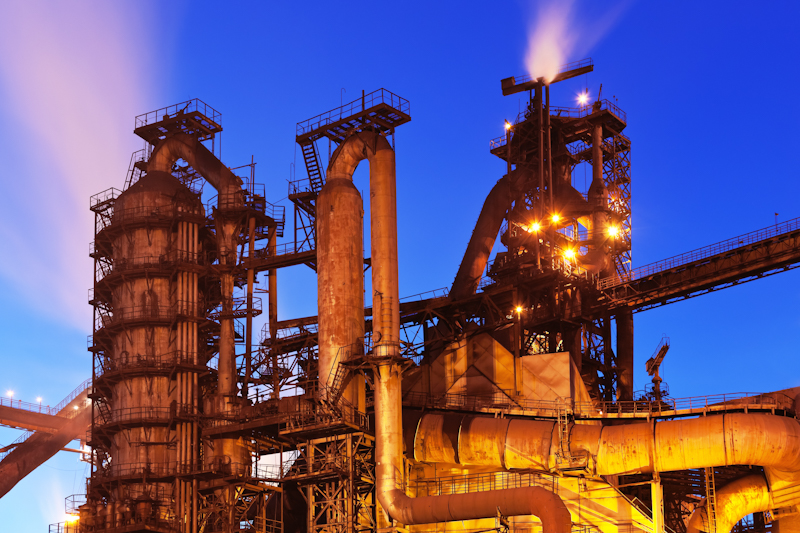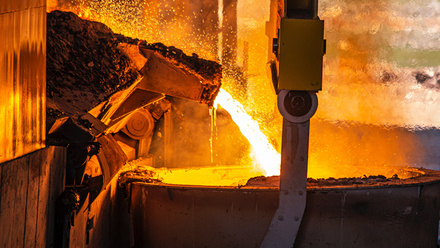Retrofitting iron and steel furnaces
A method of adapting existing iron and steel furnaces to reduce emissions by up to 90% has been developed at the University of Birmingham, UK.

Devised by Professor Yulong Ding and Dr Harriet Kildahl at Birmingham’s School of Chemical Engineering, they say that a ‘closed loop’ carbon recycling system could replace 90% of the coke typically used in blast furnace-basic oxygen furnace systems, which produce oxygen as a by-product.
Most of the world’s steel is manufactured via blast furnaces that produce iron from iron ore while basic oxygen furnaces turn that iron into steel. As a carbon intensive process, it uses metallurgical coke from the distillation of coal in a coke oven, that reacts with oxygen in hot air to make carbon monoxide (CO). The CO reacts with the iron ore in the furnace making CO₂.
The top gas in a furnace contains mostly nitrogen, CO and CO₂, which is burned to raise the air blast temperature to 1,200-1,350°C in a hot stove before blown to the furnace, with CO₂ and N₂ (that also contains NOx) emitted.
The team proposes capturing the CO₂ from the top gas and reducing it back to CO via a crystalline mineral lattice using perovskite in a thermochemical reactor. The material was chosen because the reactions occur within 700-800°C and can be powered by renewable energy or generated using heat exchangers.
Under a high concentration of CO₂, the perovskite splits the gas into oxygen that is absorbed by the lattice and CO, which is fed back to the blast furnace. The perovskite is regenerated to its original form in a low oxygen environment. The oxygen can then be used in the basic oxygen furnace to produce steel.
The paper estimates cost savings of £1.28bln in five years while reducing overall UK emissions by nearly 3%. Ding says, 'Current proposals for decarbonising the steel sector rely on phasing out existing plants and introducing electric arc furnaces powered by renewable electricity. However, an electric arc furnace plant can cost over £1bln to build, which makes this switch economically unfeasible in the time remaining to meet the Paris Agreement. The system we are proposing can be retrofitted to existing plants, which reduces the risk of stranded assets, and both the reduction in CO₂ and the cost savings are seen immediately.'
Kildahl adds, 'CO production of around 900µmol has been seen per gramme of perovskite, which is high for thermochemical materials.' She notes that this is unoptimised and new reactor designs, such as fluidised bed reactors with greatly increased solid-gas interactions, and porous perovskite pellets with higher specific surfaces areas are likely to significantly increase yields.
Accordingly, their laboratory data reveals that if the thermochemical reactor is regenerated once a day, some 2,500kg of perovskite is needed per tonne of iron produced. If porous pellets are used this could be reduced, and if the pellets have three times the surface area, then the perovskite would be reduced to 900kg/t of iron produced. The team highlights that the perovskite is not consumed so can be reused for a period of years, with no degradation after a month.
Kildahl explains that while a higher CO₂ concentration leads to improved conversion efficiency to CO, 'the system still works with lower than 10% CO₂ in nitrogen and other researchers have found CO splitting at 1,000ppm of CO₂, so a lower CO₂ concentration does not cause problems, only lowers conversion'. This new system can be retrofitted to existing furnaces, with gas separators and heat exchangers needed for the perovskite splitter.
The operation requires two thermochemical reactors runing simultaneously, one undergoing reduction and one splitting CO₂ and switching the gas flows every 24 hours for constant CO production.
With a patent pending, the team are looking for long-term partners for pilot studies to embed the technology.
Please note this is a follow-up article to the previous news story we featured on 26 January:








